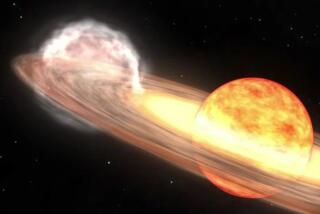Shuttle Is Set for a Showy Liftoff Tonight
- Share via
KENNEDY SPACE CENTER, Fla. — The space shuttle Atlantis is set to light the night sky in a spectacular liftoff from Kennedy Space Center this evening, at the beginning of a seven-day mission to launch three satellites and to test construction methods in space.
The launching, scheduled for 7:29 p.m. EST, is only the second at night in the history of the space program. It is expected that the fiery, 700-foot-long trail of the Atlantis will be visible throughout Florida and in parts of Georgia, South Carolina and Alabama, as well as the Bahamas and Cuba.
(In Los Angeles, the liftoff will be televised live on NBC and Cable News Network at 4:29 p.m.)
The shuttle’s crew--six men and a woman--will have a nine-minute launch window and a second, four-minute window at 8:07 p.m. If the launching is not accomplished during either slot, it must be postponed until Wednesday evening.
Sensor Needs Darkness
The launch window is so narrow because an Australian communications satellite to be deployed during the mission is stabilized by sensors that lock onto certain stars. Unless the launching comes during one of the prescribed times, one of the sensors will be briefly exposed to the sun and ruined.
Other highlights of the mission, designated 61-B, include the presence of the first Mexican payload specialist, Rudolfo Neri, who will monitor the launching of a Mexican communications satellite, the first flight of a student project from Canada and the first use of a new payload-assist module designed to lift heavy satellites into high orbits.
The three satellites will be deployed Wednesday and Thursday. Seven hours and 18 minutes after liftoff, Mexico’s second communications satellite, Morales B, will be placed in a storage orbit that will allow it to drift into its useful orbit over a two-year period. This maneuver will save fuel and allow its life to be extended by 4 years, to about 11 years. The satellite will not be activated until 1989.
Payload of Satellites
Atlantis will also deploy satellites for Aussat, the Australian equivalent of the American Comsat, and for RCA Corp. The RCA satellite, Satcom-K2, will be boosted into orbit by the new payload-assist module, which can lift 1,400 pounds more than the model in current use.
The RCA satellite will be the first commercial satellite launched without insurance coverage, which has become increasingly expensive since several recent failures.
On Friday and Sunday, mission specialists Jerry Ross and Sherwood Spring will don spacesuits for the construction of two assemblies in the shuttle’s cargo bay. Their work is designed to study techniques for building a space station.
One assembly, called ACCESS, is a 45-foot-long triangular truss formed from 93 aluminum tubes and 33 joints. The second, called EASE, is a 12-foot-high tetrahedron formed from six 12-foot aluminum beams and four joints. The astronauts will assemble and disassemble each device many times, and will simulate repairs and installation of electrical cables.
Checking on Simulations
Ross and Spring have gone through the same routines under water in the Neutral Buoyancy Simulator at the Marshall Space Flight Center in Huntsville, Ala. The primary goal of the experiment is to determine how closely the simulator mimics conditions in space.
Payload specialist Charles Walker of McDonnell Douglas Astronautics Co. will be making his third flight to operate the company’s electrophoresis device, used to purify biological products.
The other crew members are the commander, Air Force Lt. Col Brewster Shaw Jr., the pilot, Bryan O’Connor, a Marine Corps lieutenant colonel and Mary Cleave, who will operate a system for growing organic crystals under weightless conditions.
More to Read
Sign up for Essential California
The most important California stories and recommendations in your inbox every morning.
You may occasionally receive promotional content from the Los Angeles Times.













